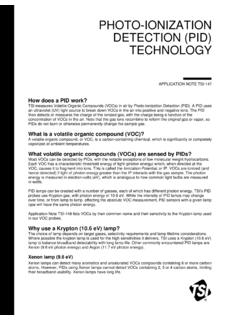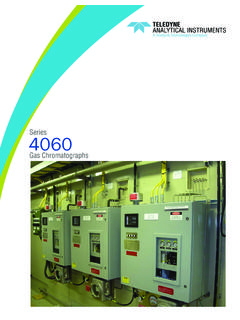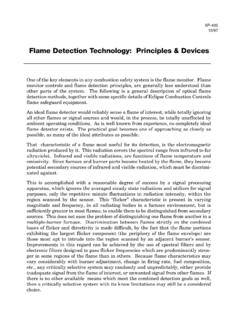Transcription of TVA 1000 Response Factor cover
1 TVA- 1000 Toxic Vapor AnalyzerThermo EnvironmentalInstruments FactorsTVA 1000 Response FACTORSP/N 50039 THERMO ENVIRONMENTAL INSTRUMENTS WEST FORGE PARKWAYFRANKLIN, MASSACHUSETTS 02038 TELEPHONE: (508) 520-0430 FACSIMILE: (508) 520-14608-23-00 Other brands and product names mentioned in this instruction manual aretrademarks of their respective 2000 Thermo Environmental Instruments, , MassachusettsPublications Comments FormThermo EnvironmentalInstrumentsDocument Part Number 50039 Fax: 508-520-1460 Title TVA 1000 Response FactorsWe continually seek to improve the content and usability of our technical documents. You can help us byanswering the questions below and mailing this form to us. Thank you for your do you use this document?Introduction to the productAdvanced programming techniquesClassroom resourceOperating instructionsSelf-studyReferenceProgrammi ng proceduresOtherHow did you get this document?
2 Received with equipmentOrdered from TEIDo not knowReceived from Sales or CustomerService RepresentativeOtherPlease rate this GoodPoorTechnicalAccuracyDoes the system work as described in the manual?ReadabilityIs the manual easy to read and understand?ClarityIs the instructions easy to follow?ExamplesAre the examples helpful and realistic?Are there enough examples?OrganizationIs the organization of the manual logical?Is it easy to find what you are looking for?IllustrationsAre the illustrations clear and useful?AppearanceWhat do you think of the layout, printing, binding, there any terms or concepts that are not defined clearly?If so, what are they? _____YesNoAfter reading this manual, are you able to use the equipment?What errors did you find in the manual? Please include page numbers. Attach extra sheets if you have any comments or suggestions? _____Name: _____ Street: _____Title: _____ City: Stop _____State/Country: _____Company: _____ Zip Code: _____ Telephone: _____Sent by_____Thermo Environmental Instruments, West Forge ParkwayFranklin, MA.
3 02038-3136 Attn: Technical PublicationsPLACESTAMPHEREvTABLE OF CONTENTSPART ONE: INTRODUCTIONF lame ionization detection (FID) .. 1-1 Photoionization detection (PID).. 1-2 Dual Detectors .. 1-3 Response 1-5 Using TVA Response Factor 1-7 PART TWO: Response FACTORSA cetic Acid .. 2-1 Acetone .. 2-2 Acetonitrile .. 2-3 Acrylic 2-4 Allyl Alcohol .. 2-6 Amyl 2-8 Benzyl Chloride .. 2-91,3-Butadiene .. 2-10n-Butane .. 2-122-Butanone (MEK) .. 2-131-Butene .. 2-14 Butyl Acetate .. 2-15 Butyl Acrylate .. 2-16 Carbon Disulfide .. 2-17 CFC 12 .. 2-18 CFC 113 ..2-19 Chlorobenzene .. 2-24n-Decane ..2-25 Dimethylformamide .. 2-26 Ethane .. 2-27 Ethanol .. 2-28vi2-Ethoxyethanol .. 2-30 Ethyl Acrylate .. 2-32 Ethyl Lactate ..2-33 Ethylene .. 2-34 Ethylene 2-35 Formaldehyde .. 2-36n-Heptane ..2-37n-Hexane ( eV).. 2-38n-Hexane ( eV).. 2-41 Isobutylene.
4 2-42 Isopropyl Alcohol .. 2-43 Isopropyl 2-44 Methanol ..2-45 MethylChloride .. 2-46 Methylcyclohexane .. 2-47 Methylene Chloride .. 2-48 MIBK .. 2-49 MTBE .. 2-53 PGME .. 2-56 Propylene ..2-57 Styrene .. 2-58 Tetrachloroethylene .. 2-591,1,1, 2-60 Tetrahydrofuran .. 2-61 Toluene .. 2-62 Trichloroethylene .. 2-63 Triethylamine .. 2-64 Vinyl Acetate .. 2-65 Vinyl Chloride .. 2-66 Vinylidene Fluoride .. 2-67 Xylenes .. 2-68viiLIST OF ILLUSTRATIONSF igurePage1-1 Typical flame ionization Detector .. 1-11-2 Typical Photoizonation Detector .. 1-31-3 TVA- 1000 Dual Detector Configuration .. 1-4 PART ONEINTRODUCTION1-1 flame ionization detection (FID)An FID, or flame ionization Detector, measures organic compounds by utilizing a flameproduced by the combustion of hydrogen and oxygen (air). When hydrocarbons in thesample are introduced to the detection zone, ions are produced by the following reaction:RH + O = RHO+ + e- = H20 + CO2A collector electrode with a polarizing voltage is also located within the detectorchamber, and the ions produced by this reaction are attracted to it.
5 As the ions migratetowards the collector, a current is produced which is directly proportional to theconcentration of hydrocarbons introduced to the flame . This current is then amplifiedand sent to a microprocessor or analog readout FID has a wide dynamic range (0-50,000 ppm for the TVA- 1000 ). This dynamicrange can be further expanded by use of a dilutor kit which reduces very high VOCconcentrations to within the dynamic range (or even linear range) of the analyzer. Thedilutor kit can also be used to enrich oxygen deficient samples by adding ambient air thatis rich in oxygen ( % usually). Low oxygen can affect the characteristics of thehydrogen flame , causing readings to be artificially elevated and possibly extinguishingthe flame . As a general rule of thumb, greater than 14 % oxygen is required to supportthe flame . If high concentrations of hydrocarbons or inert gas samples with low oxygenconcentrations are to be measured by an FID, it is advised that a dilutor kit be used tocombat the 1-1.
6 Typical flame ionization Detector1-2 Benefits Of flame ionization detection : Wide dynamic and linear range High sensitivity to most hydrocarbons Very stable and repeatable Response Ability to measure methane Virtually unaffected by CO, C02, and water vaporPHOTOIONIZATION detection (PID)A PID, or Photoionization Detector, consists of a UV lamp of a specific energy and anionization Compounds passing through the chamber are excited by photons ofUV energy from the lamp and ionized according to the following equation:R + h = R+ + e-These ions are attracted to a collecting electrode, producing a current proportional to theconcentration of the or not a compound can be detected by a PID depends upon the lamp energy andthe energy required to remove an electron from the compound (its ionization potential).If the lamp energy is greater than the compound s ionization potential, the PID will detectit.
7 The standard lamp in the TVA is eV, however other lamps are also available( , 10 0, and eV). The eV lamp permits detection of many compounds notionized by the standard lamp, while the lower energy lamps allow more selectivity by notresponding to undesired compounds with a higher ionization of its smaller dynamic range (0-2000 ppm), the PID would not be the detector ofchoice for measuring high concentrations of vapors (unless a dilutor kit is used). A PIDis also more susceptible to interference from water vapor than an FID. However, a PIDdoes not require hydrogen or oxygen, so it would be the detector of choice when fuel islimited or unavailable, or when ambient oxygen concentrations are low. The PID is alsomore sensitive to aromatic and chlorinated compounds, and can measure some inorganiccompounds that the FID does not detect at all (Ammonia, Carbon Disulfide, CarbonTetrachioride, Chloroform, Ethylamine, Formaldehyde, and Hydrogen Sulfide, to name afew).
8 1-3 Figure 1-2. Typical Photoionization DetectorBenefits Of Photoionization detection : High sensitivity to aromatics, unsaturated hydrocarbons and chlorinatedhydrocarbons Ability to measure some inorganic gases Very simple operation No support gases required Non destructive detector allows sample to be recoveredDUAL DETECTORSThe TVA- 1000 is the first of its kind. Never before has an over-the-shoulder portablevapor analyzer offered both a photoionization detector (PID) and flame ionizationdetector (FID) operating simultaneously in a single instrument. The benefits of eachindividual detector are very clear: both the FID and the PID have their advantages anddisadvantages. However, with either detector alone the number of vapors that one candetect is limited by that detector s measurement the TVA- 1000 , for truly complete survey monitoring of total vapors, two separateanalyses with an FID and a PID were imperative.
9 That could be inconvenient, timeconsuming, and expensive. With the TVA- 1000 , users can obtain complete informationabout organic and inorganic vapors quickly and easily. Most important of all, the TVA- 1000 eliminates the need to purchase, learn, operate, and maintain two separateinstruments - one analyzer does it all!1-4 Also, since both detectors are displayed and logged simultaneously, the relative responseof the two detectors can give some clues about the identity of the compound beingmeasured. For instance, the PID does not respond to methane at all, but the FID respondsvery well. A high FID reading with virtually no PID Response might indicate thepresence of naturally occuring methane, commonly found at excavation , PID s respond very well to some inorganic gases that FID s won t high PID reading with no FID reading might suggest the presence of an inorganiccompound.
10 With readings from both detectors readily available, the TVA- 1000 can helpa user make some decisions about the type of compound present and which detectorreading to 1-3. TVA- 1000 Dual Detector ConfigurationBenefits Of Dual Detectors: Excellent Value for FID/PID/Datalogger Twice as much information as each detector alone Distinguish Methane from non-Methane hydrocarbons Detector Response ratios can help characterize compounds No need to carry two analyzers, both detectors are run and logged simultaneously in asingle package1-5 Response FACTORSThe TVA- 1000 is a portable vapor analyzer for gas survey monitoring. Each unit isfactory calibrated with Methane (in the case of the FID) and Isobutylene (in the case ofthe PID). However, both detectors respond to many different compounds with differinglevels of sensitivity. In order to adjust the analyzer reading from ppm of Methane or ppm of Isobutylene to ppm of the compound of interest, a correction Factor must beapplied to the reading.





